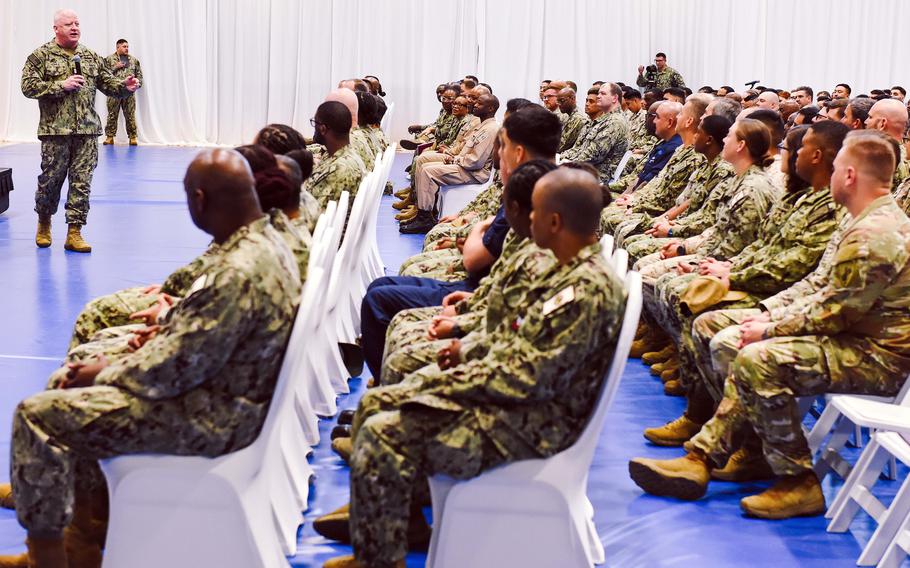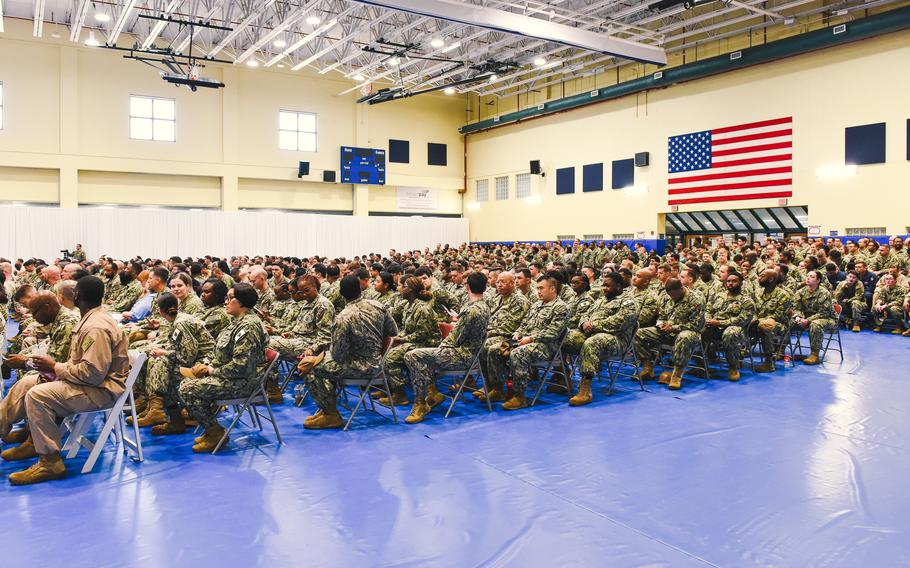
Master Chief Petty Officer of the Navy James Honea addresses sailors and Marines on April 16, 2025, during an all-hands call in Manama, Bahrain. He spoke about recruiting, military construction and veterans affairs, and answered audience questions. (Shannon Renfroe/Stars and Stripes)
MANAMA, Bahrain — Navy recruiting is making progress toward easing a long-standing manning shortage at sea, the service’s top enlisted leader told sailors in Bahrain this week.
Master Chief Petty Officer of the Navy James Honea praised recruiters during an all-hands meeting Wednesday at the service’s base in Bahrain, where he expressed optimism that strengthening the ranks will ease the burden on deployed crews.
“Last year, we met our contracting goals, and this year, we’re going to exceed those,” Honea said.
Honea’s comments come amid years of undermanning at sea. Most of the service’s surface ships, aircraft carriers and submarines can’t complete regular routine maintenance and repairs while underway, a Government Accountability Office report said in September.
Inadequate crewing of ships also keeps sailors working longer hours, limiting their available time for sleep and contributing to fatigue.
At an April 15 awards ceremony honoring the Navy Midshipmen football team, President Donald Trump highlighted the significant rise in the service’s recruitment since his second administration took office. “Today, I’m proud to announce that in February, the US Navy had its best recruiting numbers since 2002, that’s a long time ago and under my administration, the Navy is on track to have the best recruiting year since the start of the war and the war on terror, but going back further than that, probably 25 to 30 years,” Trump said.
The Navy met its 2024 recruiting goal with 40,000 contracts and expects to have those recruits deployed by year’s end, narrowing the 20,000-sailor-at-sea shortfall to 18,000. It aims to fill 10,000 more sea-duty billets, with 100% of billets filled by 2027, Vice Adm. Richard Cheeseman said during Senate testimony on April 9.

Sailors and Marines gather April 16, 2025, for an all-hands call in Manama, Bahrain, with Master Chief Petty Officer of the Navy James Honea. (Shannon Renfroe/Stars and Stripes)
Cheeseman, the Navy’s top personnel officer, said that progress is being made but that it takes at least nine months for recruits to move through the full training pipeline. During the all-hands call, Honea explained that the service has adapted its training pipeline to handle the influx of new sailors “so we don’t end up with any kind of bottleneck along the way.” The Navy credits recent recruiting gains to cultural shifts, including the “Every Sailor a Recruiter” initiative and the appointment of a two-star admiral to oversee recruiting operations.
It also eased pressure on recruiters by shifting from monthly quotas to annual goals, promoting steadier performance in what is already a mentally demanding assignment. Boosting training capacity at boot camp and technical schools ensures that the Navy can “flow people as quickly as possible out to the fleet,” Honea said.
But reaching the point where ships are fully crewed again is not going to happen in the near term, he cautioned, saying that “it takes a couple of years for us to get that water spigot turned back on” and fill the ranks.